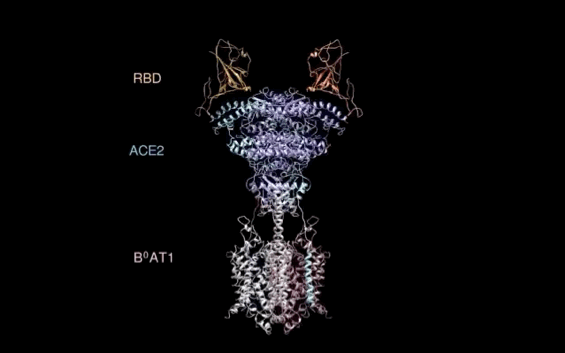On the afternoon of June 15, the Zhejiang Science and Technology Awards Conference was held in the Provincial Great Hall of the People. At the meeting, 301 Zhejiang Science and Technology Awards were awarded, including 1 Zhejiang Science and Technology Award, which was won by Academician Pan Yunhe; 299 achievements (projects) won the Provincial Natural Science Award, Technological Invention Award, and Science and Technology Progress Award, among which the first class 44 awards, 90 second prizes, 165 third prizes; 1 international scientific and technological cooperation award.
News (www.thepaper.cn) reporter was informed that the research related to the new coronavirus by the Zhou Qiang team of West Lake University and West Lake Laboratory won the first prize of Zhejiang Province Natural Science Award in 2020. Prize.
According to the official news of West Lake University, in February 2020, shortly after the outbreak of the new crown epidemic, Zhou Qiang’s team used cryo-electron microscopy technology to “see clearly” the new crown virus invaded the human body The situation at the first moment. Previously, on February 18, 2020, local time, Zhou Qiang’s laboratory published the research result “Structure of dimeric full-length human ACE2in complex with B0AT1” on the life science preprint platform bioRxiv. The team successfully analyzed the new coronavirus by using cryo-electron microscopy technology. The full-length structure of the receptor-ACE2 (Angiotensin Converting Enzyme 2). This is the world’s first analysis of the full-length structure of ACE2. Two days later, Zhou Qiang’s team posted another article on bioRxiv, reporting the cryo-EM structure of the complex of the S protein receptor binding domain on the surface of the new coronavirus and the full-length protein of the cell surface receptor ACE2, revealing how the new coronavirus invaded human cells.  The above two achievements were finally on March 4, 2020, local time It was published online in the top academic journal “Science”, entitled “Structural basis for the recognition of the SARS-CoV-2 by full-length human ACE2”.
The above two achievements were finally on March 4, 2020, local time It was published online in the top academic journal “Science”, entitled “Structural basis for the recognition of the SARS-CoV-2 by full-length human ACE2”.
During the new crown, Zhou Qiang’s team also worked with the team of Academician Chen Wei of the Academy of Military Medical Sciences to isolate and identify monoclonal antibodies (mAbs) from the plasma plasma of patients recovered from the new crown. A research work they collaborated on was published in Science on June 22, 2020 local time, entitled “A neutralizing human antibody binds to theN-terminal domain of the Spike protein of SARS-CoV-2”. This study reported a completely human neutralizing monoclonal antibody 4A8, which can recognize the epitope of the N-terminal domain of the Spike protein of SARS-CoV-2. The functional mechanism is independent of receptor binding inhibition. The research team believes that 4A8 combined with RBD targeting antibody may avoid the escape mutation of the virus and become a promising “cocktail” therapy. 
Zhou Qiang’s team is also committed to studying the molecules of the new coronavirus invading human cells Mechanism. In March of this year, Zhou Qiang’s team published an online paper entitled “Structural basis for the different states of the spike protein of SARS-CoV-2 in complex with ACE2” in the journal Cell Research for in-depth research. The conformational changes in the process of the new coronavirus S protein binding to the cell receptor ACE2, and further explained the molecular mechanism and structural basis of the process of S protein invading human host cells.
According to West Lake University According to the official website, Zhou Qiang studied undergraduate at Tsinghua University from 2000 to 2004 and received a bachelor’s degree. From 2004 to 2012, he studied under Academician Sui Senfang and received his doctorate at Tsinghua University. After graduation, he continued to stay in the laboratory for postdoctoral research. 2015 After leaving the station, the post-doctorate worked as an associate researcher in the research group of Professor Yan Ning of Tsinghua University School of Medicine. In early 2019, he joined West Lake University as a West Lake Scholar and Distinguished Researcher to carry out independent research.
Zhou Qiang has been engaged in the study and research of cryo-electron microscopy single particle technology for a long time, and worked with colleagues and collaborators to analyze the structure of many important biological macromolecule complexes or membrane proteins. His main work includes SNAP-SNARE complex, inflammatory body complex, Niemann -Pick C1 (NPC1) protein, eukaryotic voltage-gated sodium ion channel, etc. The resolution of the eukaryotic voltage-gated sodium ion channel combined with the gated regulation toxin Dc1a and tetrodotoxin has reached 2.6 angstroms, which is currently published frozen The highest resolution of the membrane protein structure analyzed by the single particle technology of electron microscopy has laid the foundation for the subsequent development of structure-based small molecule drugs.